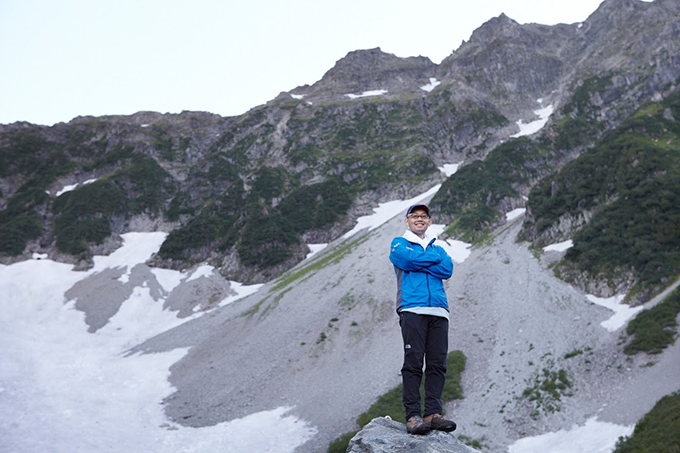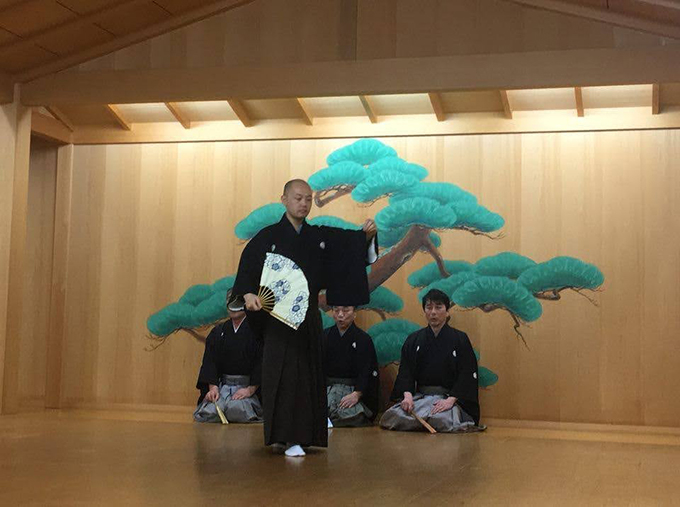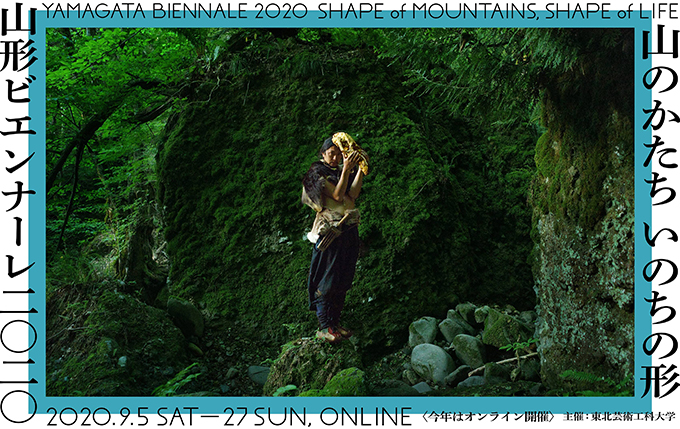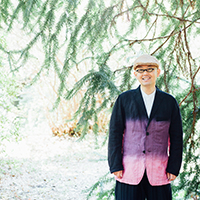Crossing Borders, Engaging in Exchanges and Harnessing the Power of Creation amid COVID-19
Interview and Contribution Series <1>
Inaba Toshiro, Doctor and Art Director of Yamagata Biennale 2020
December 16, 2020
[Special Feature 073]
In this first issue of our special feature "Crossing Borders, Engaging in Exchanges and Harnessing the Power of Creation amid COVID-19" (click here for a special feature overview), we welcome Inaba Toshiro, an active doctor and the art director of Yamagata Biennale 2020 "Shape of Mountains, Shape of Life." We asked Dr. Inaba how he views living and life amid the COVID-19 pandemic. What does he think about engaging in dialogue with people in a broad range of fields, including traditional performing arts, arts, folklore and agriculture?

At Karasawa Cirque, where the Karasawa Clinic (Matsumoto City, Nagano Prefecture) is located. Dr. Inaba was also the director of the mountain club of The University of Tokyo and was involved in providing mountain medical care at the Karasawa Clinic during summers.
(Photo courtesy of Dr. Inaba)
――How do you feel about the current state of COVID-19 from your standpoint as an active doctor?
What concerns me most are the issues of discrimination and division. Whenever someone gets infected by COVID-19, slandering occurs, restaurants are forced out of business, families are discriminated against and the infected are told to stay away from work, kindergarten or school. But if someone gets sick, words of caring should be in order: "Is everything okay?" "How are you doing?" or "Hang in there and get well soon." When it comes to COVID-19, I wonder why people's responses are exactly the opposite in our present society. I believe one reason is crowd anxiety that causes everyone to turn on innocent victims. This is similar to the psychology of siding with a bully because people themselves fear being bullied. I think this is why people will excessively discriminate against and criticize somebody who tests positive for the virus.
One of my hopes for addressing this problem is the example set by the residents of Yoron Island on the Amami Islands of Kagoshima Prefecture. There were successive infections among the residents of Yoron Island, which has a population of about 5,000 people. Because persons testing positive cannot be treated on Yoron Island, they must be transported to hospitals on the mainland in Kagoshima. Rather than discriminating, residents sent off patients who were to be hospitalized in the mainland with messages of encouragement and support. I heard there was an atmosphere among all Yoron Island residents to encourage returning patients with words of support and to overcome these difficult circumstances together.
Will we move toward becoming a society where discrimination, division, criticism and complaints are commonplace? Or will we become a society where people care about each other, express kindness and goodwill, and help each other? I think we are now standing at a crucial crossroads for determining the direction of our society.
――How can we become more like the people of Yoron Island?
I believe a major factor is that everyone on the entire island has worked to create a supportive community. Besides outbreaks of infectious diseases, various disasters can occur in the future. However, people can overcome these problems if they are prepared. It is important to consider what kinds of places and communities we should create. I strongly believe this is an urgent issue that we must address now.
Even with the plague that proliferated at the end of the 19th century, it took about 10 years for a certain degree of calm to be restored and for society to transition to a new phase. Similarly, I think the shape of our social infrastructure will evolve over the next 10 years. One of these changes will involve the online world. The Yamagata Biennale 2020 (from September 5 to 27, currently distributing archives) was held online. I started preparations from the concept of creating a social infrastructure in the art world that can continuously move back and forth (between the real and online worlds) under any circumstances, be it normal times or in times of an emergency.
Social infrastructure is important. However, I think dialogue technique is one crucial issue that we should all work on together. A society where everyone engages in dialogue is important. I always sense the potential of dialogue when interacting with my patients in healthcare settings. In counseling for mental illnesses such as depression, symptoms can be eased just by listening to what they have to say. Dialogue can also persuade people who have lost all hope in society and are contemplating suicide to decide against it and go on with their lives. I believe in many possibilities for dialogue.
――In other words, does this mean that sufficient dialogue is lacking in our society?
I believe there has been no "proper" dialogue. Children learn by emulating adults. For example, when adults communicate in a setting dominated by anger or violence, a child learns that this is the normal form of behavior. I feel the time is ripe for us to learn genuinely creative dialogue in the true sense of the word.
With the desire to sow the seeds of proper communication, at Yamagata Biennale 2020 we are holding dialogues between medical students and art students who will lead our future. What we stress most is on the methods and techniques of dialogue. It's easy to say, "Please have a conversation," but I always say, "Let's set three rules for dialogue." First is to praise and respect the other person. Second is to talk about the future. Third is to not jump to conclusions.
"Talking about the future" means that if dialogues focus only on old ideas and are not forward-looking, this will never be productive. Sharing an awareness of the importance of "not jumping to conclusions" prevents a situation in which what a person says gets rejected outright and he/she thinks that talking further to the other person is just a waste of time. "Praising and respecting the other person" doesn't mean just flattering them. It means properly understanding and respecting the opinions and ideas of the other person. This awareness should be shared while engaging in dialogue. By merely creating channels for such small dialogue, we can realize creative, future-oriented and high-quality dialogue. Dialogue has the potential to offer solutions in every situation, from small rifts in human relations to ultimately community problems and international dispute issues. I believe that over the next 10 years, dialogue will be key to creatively alleviating the instability of contemporary society brought on by the spread of COVID-19.
――So you're talking about looking for points of collaboration rather than points of conflict while ensuring diversity.
I'm talking about realizing a society where everyone respects and understands each other as opposed to becoming an increasingly divided society within the structure of conflict. How can we respect each other's freedoms and happiness and create a society that avoids alienation and ostracization? I believe this is a wonderful social experiment and a challenge that humankind should take on. I always like to place my bets on the powers of dialogue whenever I think about what specific contexts and methods should be used to assure respect for diversity.
When I was appointed artistic director of the Yamagata Biennale 2020, I set the major theme of "Regaining Wholeness." I set this theme as a question rather than an answer. On the surface people may have different ideas on "wholeness," but at a deeper level there is a common theme. People can gather on common platforms and have proper conversations. Everyone lives in a different world and a different reality. However, if we adopt the perspective that wishing to regain "wholeness" is a common concept, I think we can become a society where everyone is able to understand and respect each other's standpoints.
――"Wholeness" is different from totalism where everyone is doing the same thing, isn't it? Does it mean people cooperate despite their own individuality while harmony is still attained overall?
That's right. In the Analects Tsze-lu edition, Confucius states, "Wise men harmonize but do not align, dwarfs align but do not harmonize." There is an expression that dwarfs and boring people don't cooperate but they easily synchronize, while wise men and good people cooperate with everyone in harmony but never possess the same thinking. I believe this is perhaps the difference between totalism and harmonious wholeness in which individuality is respected yet the wholeness of the individual is regained. With totalism everyone has the same thinking and nobody has their own ideas. There is nothing to worry or think about. As opposed to totalism, wholeness advocates dialogue that firmly connects to the core of each person's life and encourages effort in cooperating and harmonizing with others despite differences in opinions, the way of living or beliefs. They sound similar yet totally different. I believe this is an important point.
It can be said that the relationship between individuals and places is the theme of humanity itself. For example, although gorillas and chimpanzees belong to the same primate species, gorillas value the community formed by their families. On the other hand, chimpanzees dissolve their families and flock within a strong hierarchy headed by a boss chimpanzee. Although ants and bees also form groups, numerous wild creatures live as individuals rather than in groups. The interests of individuals and groups inherently conflict. Individual happiness and group happiness are prone to conflicting interests and contradictions. A challenge unique to human beings is to enable these conflicting interests and contradictions to exist peacefully and maintain a delicate balance. Only humans are capable of building cities and nations, and dialogue is essential for doing so. Human beings have been blessed with the magnificent ability to engage in dialogue. This is essential for living with a multi-layered balance between both minimums and maximums, namely, the happiness of individuals and the happiness of families, groups and communities, or, more broadly speaking, the happiness of nations or the earth.
――As a specific practice, does this mean creating places for dialogue starts from areas around you such as a small community?
I think that an issue for each person is to build solid lives and communities while making efforts in their own places, engaging in practical dialogue and learning from each other. Dialogues within the family and community lead to dialogues within larger organizations that align with their roles. It's better to take the initiative and undertake dialogue in societies where the minimum level of safety is guaranteed, such as in Japan, where no civil wars break out regularly. When people from various backgrounds visit Japan, I want them to feel affection and inspiration about Japan. Dialogue is also influenced by the linguistic structure of one's native language, so I think this also facilitates mutual understanding and learning of the basics of each other's language.
I also think that new medical settings can serve as places where people can share their philosophy of life. As one symbol of this, we can create a society where everyone can gather around together to naturally engage in dialogue in shared space that nurtures life, for instance, a farming field. Then, just like waterways that nurture rice paddies, a waterway for dialogue will flow naturally and life will emerge as the centerpiece of society. I would also like to make efforts to engage in this kind of dialogue. If we don't wish to create a society filled with discrimination and division, we need to contribute as much as possible in our own capacities rather than waiting for someone else to act first.

Since the Great East Japan Earthquake, Dr. Inaba has been studying Noh (Kanze style) to learn the significance of a ceremony for the repose of departed souls and traditional Japanese movements and aesthetics. This photograph was taken at a Shakujii Noh stage presentation.
(Photo courtesy of Dr. Inaba)
――Due to COVID-19-induced social distancing, we are unable to meet other people. How do you think it will shape encounters and relationships between people in the future?
Actually, we are not facing a situation where people can't physically meet at all. People can still meet during an infectious disease outbreak as long as they properly protect themselves against infection, avoid the 3Cs and maintain adequate distancing. I feel that "not being able to meet" is overemphasized. Conversely, I believe now is the time to examine and think about the need to meet people. Rather than randomly meeting an unlimited number of anonymous people, we should meet only with those persons we really want to meet or should meet. While maintaining appropriate distancing, we should value meetings with those persons we rarely have a chance to meet. So if you think this is the right time for doing this, then all things aren't so bad. For example, I think this is an opportunity for everyone to consider the meaning of family. I'm looking at current trends in a positive light. People should think about who they want to meet, what they want to discuss and what kinds of interaction they seek. Rather than having idle conversations, this is the time to be more clearly focused on the details of our dialogues.
――It's also important to reflect on oneself.
In today's information-intensive society, there's a plethora of external information and one's attention thus tends to turn outward. However, inside each of us there is in fact life information similar to an eternal fountain. Having time to face and reconnect with the world of life inside yourself is also important. This is what I value most when discussing commonalities between art and medicine. It's similar to sleep being important to humans. Sleep is the symbolic act of returning to your own nest in life. People will become increasingly detached from their own selves if they ignore this and their consciousness is pulled too much toward the outside by such things as authority, honor, money and external appearance. The time for secluding oneself is a time for understanding the significance of mechanisms given by life. I want everybody to make this a time for having a philosophical dialogue with themselves and ponder the fundamental aspects of life such as why you were born and why you are alive.
――Does this mean listening to the voices of your body and mind?
Yes, in a nutshell that's what I mean. This also means that we've become a society in which we can live even if we ignore the voices of our own bodies and minds. I wish we had more time for philosophical dialogue. We should take the time to return to the origins of life and think about how the body and mind that form us can live vigorously and carry on life through generations. We should also think about how our bodies and minds perform their best while our human lives maintain wholeness and go on despite being hurt or sad. By doing this, I believe we can empathize with those who are socially vulnerable or suffering.
――Then affirming that everyone lives with their own life might lead to a society with wholeness where we can respect each other even if we have different opinions and ideas.
I believe so. Each and every person having lives that overlap to form society is a basic. Respect for our existence is also a basic. For these reasons, I'd like to see each person treasure the habitats of their own lives. You can't value other persons without caring for yourself. Besides other persons, your inner self is also important. We have learned this as we grew up and feel like we understand this, but we may have forgotten the basic and most important things. I think everyone needs time to relearn these essentials with the same feeling as relearning from a state of innocence just like that of an infant.

Yamagata Biennale 2020 poster. This expresses an existence that is searching for the shape of a new world by connecting the natural world and the human world with Sakamoto Daizaburo of Yamabushi (Buddhist mountain priest) as a model.
(Photo courtesy of the Yamagata Biennale Secretariat)
――What were the factors behind your decision to hold Yamagata Biennale 2020 now? Also, the title includes "Life." How are culture and art connected to life and the body?
I thought the power of culture and art is actually what's most needed in the current crisis, so it never occurred to me to cancel or postpone the program. I thought that if discrimination, division and slander amid the COVID-19 pandemic are proof that people are losing their emotional leeway and their spirits are becoming dried out, rough and unstable, then there will never be a better time to harness the power of art, culture and music to soothe people's spirits the same way rains fall to make soil fertile. In response to the words "non-essential and non-urgent," I think there is art that is essential as an emergency remedy for soothing people's hearts. While thinking about the role of the art festival, I wanted to share something that can only be done right now. As with in the healthcare industry, I thought in the arts and culture world there must be urgent issues and themes that need to be promoted now. In fact, I think that the Yamagata Biennale 2020 also raised some timely issues and was thus received favorably. This seems to emanate from the wholeness of the exhibited works.
――How was the reaction and response after the opening?
I felt there was a considerably strong response. I called out to everyone, "Even if we fail, that's proof of a challenge, so let's hold this as a challenge for a new era." I was glad they responded sincerely. I also sensed the passion indicating that the audience could also feel the essential parts. The organizers made preparations by delving deeply and subconsciously into the significance of holding the event now. So I think that the strength and depth are becoming apparent in the artistic expressions. We all sensed that how much dialogue the artists had with their deep subconscious affected the quality, strength and energy of their works.
――You say that you've never separated art from medicine.
For me, they are not separate. Look at children. For them living is synonymous with singing, dancing and other physical activities. I think that such sensibilities are probably intrinsically the life activities of humans. I have never forgotten and treasure this feeling. I have the impression that we increasingly separate wholeness as we grow. However, I have personally never dared to try to separate this and if the relationship breaks then I have tried to reconnect it. This is an important matter for ensuring that I as a whole don't become discordant. In actuality, I sense this is really a medical-related element.
Losing relationships by creating walls, dividing, categorizing and dismantling is not the way of undertaking life activities. Life is an activity that restores wholeness and values harmony. For this reason, the parts must connect and resonate with each other via passages and waterways so that the entire circuit will start to circulate and begin moving. I wish to do this at the art festival and in my medical activities. While I have put this into practice over the last 10 years, I would like to draw back from the scene so that I can hand this over to the next generation.

Born in Kumamoto in 1979, Inaba Toshiro is a doctor and doctorate of medicine. After working as Assistant Professor, Department of Cardiovascular Medicine, The University of Tokyo Hospital (2014-2020), he served concurrently as the Director of General Medicine Division, Karuizawa Municipal Hospital, Associate Professor of the Shinshu University Research Center for Social Systems, Visiting Researcher of the Research Center for Advanced Science and Technology, The University of Tokyo and Visiting Professor of Tohoku University of Art and Design. (Yamagata Biennale 2020 Art Director)
[Single author] What Wakens Life -- Human Mind and Body (2017), Life Becomes Later Life (2020) (both published by Anonima Studio); The Body Rolls Over and Over: Thinking About "Life" to Live in This World (2018, Shunjusha Publishing Company); Body and Mind Health Science (2019, NHK Publishing, Inc.)
[Translation] Natural Breathing Techniques Matched to Body Design -Adjust Breathing with the Alexander Technique (2018, IDO-NO-NIPPON-SHA, Inc.)
Official website: https://www.toshiroinaba.com/
Yamagata Biennale: https://biennale.tuad.ac.jp/
Online interview in September 2020
Interview/text: Terae Hitomi (Japan Foundation Communication Center)
Related Articles
Back Issues
- 2025.6. 9 Creating a World Tog…
- 2024.10.25 My Life in Japan, Li…
- 2024.5.24 The 50th Japan Found…
- 2024.5.24 The 50th Japan Found…
- 2024.5. 2 People-to-People Exc…
- 2024.5. 2 People-to-People Exc…
- 2023.12. 7 Movie Theaters aroun…
- 2023.6.16 The 49th Japan Found…
- 2023.4.24 The 49th Japan Found…
- 2022.12.27 Living Together with…

